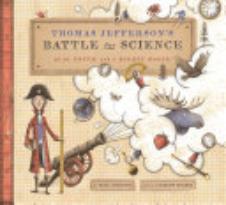Encyclopedias
3 Reviews
(1)
K-3
Illustrated by
Jeremy Holmes.
As a product of the Age of Reason, Thomas Jefferson was long fascinated by science in general and the natural world in particular. Consequently, when he first read a French encyclopedia by the renowned scientist Comte de Buffon that declared the American colonies inferior because the native animals were neither as large nor as ferocious as their European counterparts, Jefferson questioned Buffon's reasoning -- partly because of the audacious comments, partly because of national pride, and partly because Jefferson did not want to discourage immigration. For years he challenged these assumptions by asking questions; creating counterarguments; conducting experiments (which included the shipping of a dead moose to France to verify its large size); and formulating and publishing his conclusions. In other words, he followed the scientific method, nicely summarized in the back matter. The mixed-media illustrations, crafted with woodblocks and pencil, are highlighted in unusual and effective layouts. The written narrative appears in text boxes, acting either as previews for the often-humorous illustrations (for example, ideas explode from Jefferson's head as he writes his own book challenging Buffon) or as comic panels. A concluding author's note explains the sources and dangers of misinformation and ways to identify and combat such rumors, as well as a timeline of Jefferson's life and a bibliography -- appropriately, for the topic -- divided into primary and secondary sources.
Reviewer: Betty Carter
| Horn Book Magazine Issue:
May, 2024
(3)
4-6
These two different ways of organizing animals worldwide both begin with overviews of the animal kingdom; Atlas groups animals by continents and regions, Wild by five major types. Both books are lavish with photos, illustrations, and descriptive captions, and colored borders and headers keep things organized. Overlap is inevitable, but the writing is clear, intelligent, and unsensational. Atlas contains a glossary. Ind. Review covers these titles: Animal Planet Atlas of Animals and Animal Planet Wild World.
Reviewer: Frieda F. Bostian
(4)
K-3
Super SandCastle: Library Resources series.
Cheesy staged photographs of young, enthusiastic "researchers" welcome primary-grade readers on a quick tour of print and computer resources for report writing. Simple, easy-to-read texts, sidebars, and labeled photos provide brief introductions to encyclopedias, databases, and dictionaries, the information within, and how to access it. These overviews are clearly organized, and the presentations are inviting. Glos. Review covers these Library Resources titles: What Would You Do with a Database?, What Would You Do with a Dictionary?, and What Would You Do with an Encyclopedia?.
Reviewer: Tamara DePasquale
3 reviews
We are currently offering this content for free. Sign up now to activate your personal profile, where you can save articles for future viewing.






